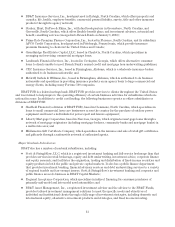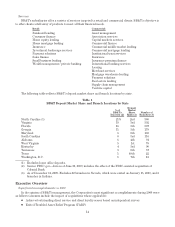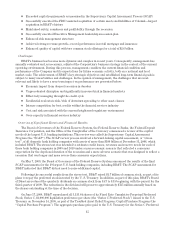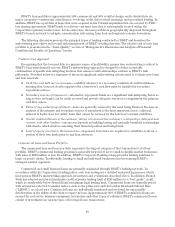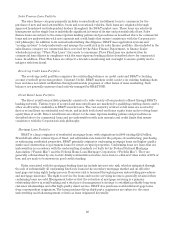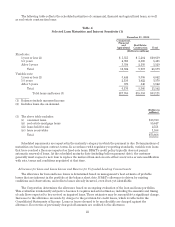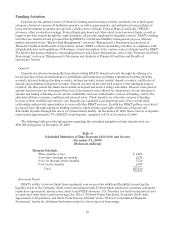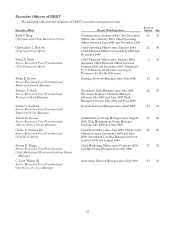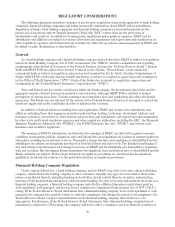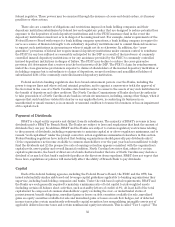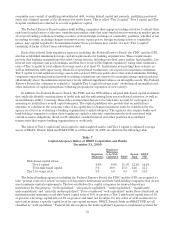BB&T 2009 Annual Report Download - page 23
Download and view the complete annual report
Please find page 23 of the 2009 BB&T annual report below. You can navigate through the pages in the report by either clicking on the pages listed below, or by using the keyword search tool below to find specific information within the annual report.In addition to the allowance for loan and lease losses, BB&T also estimates probable losses related to binding
unfunded lending commitments. The methodology to determine such losses is inherently similar to the
methodology used in calculating the allowance for commercial loans, adjusted for factors specific to binding
commitments, including the probability of funding and exposure at funding. The reserve for unfunded lending
commitments is included in accounts payable and other liabilities on the Consolidated Balance Sheets. Changes to
the reserve for unfunded lending commitments are made by charges or credits to the provision for credit losses.
Reserve Policy and Methodology
The allowance for loan and lease losses consists of (1) a component for individual loan impairment and
(2) components of collective loan impairment, including a component that is unallocated. BB&T maintains specific
reserves for individually impaired loans. A loan is impaired when, based on current information and events, it is
probable that BB&T will be unable to collect all amounts due (interest as well as principal) according to the
contractual terms of the loan agreement. On a quarterly basis, BB&T reviews all commercial lending
relationships with outstanding debt of $2 million or more that have been classified as substandard or doubtful.
Loans are considered impaired when the borrower does not have the cash flow capacity or willingness to service
the debt according to contractual terms, or it does not appear reasonable to assume that the borrower will
continue to pay according to the contractual agreement. The amount of impairment is based on the present value
of expected cash flows discounted at the loan’s effective interest rate, and/or the value of collateral adjusted for
any origination costs and nonrefundable fees that existed at the time of origination.
Reserves established for collective impairment reflect an estimate of losses inherent in the loan and lease
portfolios as of the balance sheet reporting date. Embedded loss estimates are based on current migration rates
and current risk mix. Embedded loss estimates may be adjusted to reflect current economic conditions and
current portfolio trends including credit quality, concentrations, aging of the portfolio, and significant policy and
underwriting changes. In the commercial lending portfolio, each loan is assigned a “risk grade” at origination by
the account officer and the assigned risk grade is subsequently reviewed and finalized by a credit officer. Further,
Credit Risk Review, a department that is independent of the loan administration functions, validates the risk
grades of selected relationships through their loan review system. Loans are assigned risk grades based on an
assessment of conditions that affect the borrower’s ability to meet contractual obligations under the loan
agreement. This process includes reviewing borrowers’ financial information, historical payment experience,
credit documentation, public information, and other information specific to each borrower. The established risk
management regimen includes a review of all credit relationships with total credit exposure of $1 million or more
on an annual basis or at any point management becomes aware of information affecting the borrower’s ability to
fulfill their obligations. For small business and commercial clients where total credit exposure is less than $1
million, BB&T has developed an automated loan review system to identify and proactively manage accounts with
a higher risk of loss. The “score” produced by this automated system is updated monthly. All of the loan portfolios
grouped in the retail lending and specialized lending categories typically employ scoring models to segment
credits into groups with homogenous risk characteristics. Scoring models are validated on a periodic basis in
order to ensure reliable default rate information. This information is employed to evaluate the levels of risk
associated with new production as well as to assess any risk migration in the existing portfolio. For loans
acquired in a business combination after December 31, 2008, BB&T has generally aggregated the purchased loans
into pools of loans with common risk characteristics. In determining the allowance for loan and lease losses,
BB&T performs analysis each period to estimate the expected cash flows for each of the loan pools. To the extent
that the expected cash flows of a loan pool have decreased since the acquisition date, BB&T establishes an
allowance for loan loss.
A small portion of the Corporation’s allowance for loan and lease losses is not allocated to any specific
category of loans. This unallocated portion of the allowance reflects management’s best estimate of the elements
of imprecision and estimation risk inherent in the calculation of the overall allowance. Due to the subjectivity
involved in determining the overall allowance, including the unallocated portion, the portion considered
unallocated may fluctuate from period to period based on management’s evaluation of the factors affecting the
assumptions used in calculating the allowance, including historical loss experience, current economic conditions,
industry or borrower concentrations and the status of merged institutions. The allocated and unallocated portions
of the allowance are available to absorb losses in any loan or lease category. Management evaluates the adequacy
of the allowance for loan and lease losses based on the combined total of the allocated and unallocated
components.
23


